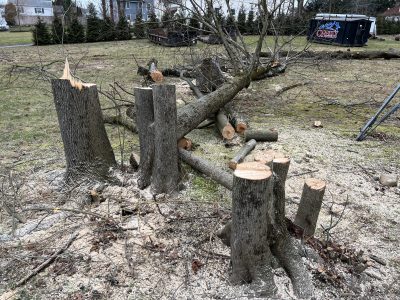Developer Apologizes for Wrongful Tree Removal in Pleasantville
News Based on facts, either observed and verified directly by the reporter, or reported and verified from knowledgeable sources.

The Pleasantville developer who received approval to build two houses and who cut down five trees without authorization apologized to the village’s Planning Commission last week and must complete a plan to replant new trees.
Appearing before the commission last Wednesday evening was George O’Reilly who received approval last June to build the houses at 18 and 20 Clark St., near the corner of Bedford Road.
An additional two trees were removed from 18 Clark St. and three extra trees were taken down at 20 Clark St., which violated the site plan. O’Reilly is building a single-family home on each parcel, each a little more than a quarter of an acre.
The issue has raised the ire of community members and village officials. Last week, the commission wanted to know why O’Reilly took the action, which wasn’t part of the approved plans.
O’Reilly said it was his decision to take down the unapproved trees.
“It was a one-day cut,” he said. “We were in the process of taking the trees down. I didn’t have the hindsight to bring (Building Inspector) Robert Hughes out. If I did, we would be a month later in the job. For that I apologize.”
O’Reilly added that when the commission asked him to alter the site plan by moving the house at 20 Clark St. back another 10 feet, it changed the scope of the project by requiring the cutting of more trees.
Planning Commission Chair Russell Klein said he was troubled by O’Reilly’s explanation.
“As you said we extensively reviewed the trees, that there was a push and pull when you wanted those trees out, and eventually the consensus was to leave those trees alone,” Klein said. “Because you didn’t want to delay the project, you went ahead and did it and choose to ask forgiveness instead of asking permission. I think that’s probably the prime concern of all the backlash you’ve heard.”
Klein also raised the issue of potential lapses in the approval process.
“Does an applicant know that if they do want to vary from the approved site plan that they need to come back through the Building Department and to the Planning Commission?” he asked. “That’s where it fell apart. You chose to take a different path and it backfired and caused a lot of ruckus in the community.”
O’Reilly agreed that he should have returned to the building department before cutting down the extra trees.
“That should’ve been done,” he acknowledged. “Could there be some mechanism that isn’t necessarily a two- or four-week process?”
Klein noted that the commission already meets twice a month.
“That’s more than most other communities. If there is something an applicant wants to change, the building department puts them on the agenda,” Klein said. “Two weeks is not that much of an inconvenience in a project of this size.”
Commission member Henry Leyva said if O’Reilly had asked to amend the application to reflect the additional tree removal, he likely would have been supportive.
“The trouble is there is a pattern of people who aren’t coming back to us when they make changes,” Leyva explained. “We are at a disadvantage because we have to review these things and there’s an enforcement issue. While we can’t be tone deaf to the needs of the developer and the builders, we can all keep communicating so this doesn’t keep happening.”
Elements of two other recent projects in Pleasantville, the exterior appearance of the Depew Street housing project and the mechanicals atop the roof of 70 Memorial Plaza, also failed to match approved plans.
Alan Pilch, the project’s site engineer, said some of the trees were too close together, necessitating additional removal.
“The two Norway maples taken down were invasive, non-native species that were at the very inside edge of the property,” Pilch explained. “The other trees taken down were in the rear of the 20 Clark St. property that had shallow roots, and construction activity would have impacted those trees.”
The mitigation plan proposed two additional trees to be planted on the 18 Clark St. property, a sugar maple and a prince dogwood, both of which are native and non-invasive. Four additional trees planted at the 20 Clark St. parcel will be a prince dogwood, red maple and two vernal witch hazel, also native and non-invasive.
Attending last week’s commission meeting was Ben Serebin of the Pleasantville Climate Smart Committee. He said plans required tree protective fencing and root protection, which failed to be done.
“That was in the plan that got submitted and it’s still not in place,” Serebin said. “You have machinery on the property and you don’t want to drive over the roots. Also, there has been no erosion and sediment plan, which is important when you take down extra trees. That’s trouble.”
Serebin said afterwards that the meeting was “surreal and a disappointment.”
“O’Reilly not only confessed to a crime, he violated the rule,” he continued. “One of the purposes of government is to protect public resources, and trees are public resources. The primary purpose of builders is to make money and not to protect anything.”
Since village regulations don’t address penalties for disregarding approved plans, Serebin advocated for a stop-work order.
“It would be the best penalty for the builder,” Serebin said. “You can’t just do what you want and apologize after.”
In January, a draft tree ordinance was proposed by the village’s Conservation Advisory Council, which supports preservation of trees throughout the village. The ordinance aims to strengthen penalties for violating site plans or permits and for performing work without permits.

Abby is a seasoned journalist who has been covering news and feature stories in the region for decades. Since The Examiner’s launch in 2007, she has reported extensively on a broad range of community issues. Read more from Abby’s editor-author bio here. Read Abbys’s archived work here: https://www.theexaminernews.com/author/ab-lub2019/
